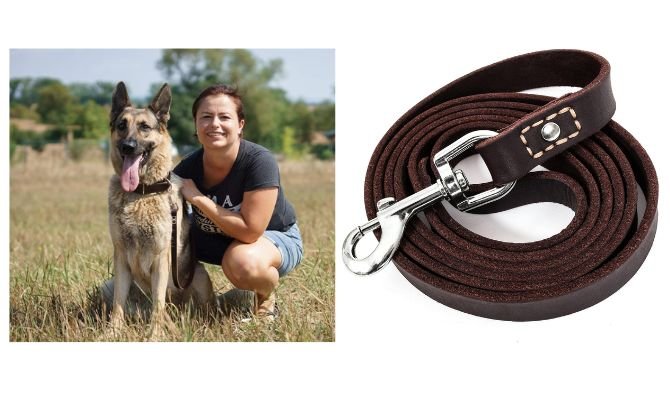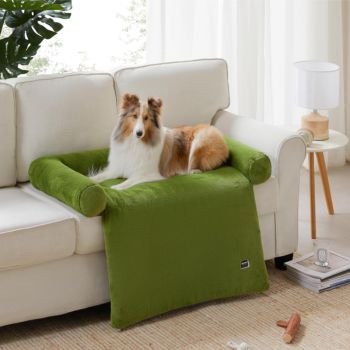Welcoming a new dog into your family comes with the responsibility of ensuring their safety and well-being. One essential aspect of pet ownership is getting your furry friend accustomed to wearing a collar and leash. Whether you have a playful puppy or an older rescue dog, helping them feel comfortable with these accessories is crucial for enjoyable walks and outdoor adventures.
Understanding Your Dog’s Behavior
Fear and Anxiety Associated with Collars and Leashes
For many dogs, the sensation of wearing a collar and being tethered to a leash can be unsettling. This discomfort often stems from unfamiliarity and past negative experiences. Dogs may exhibit signs of fear or anxiety, such as trembling, attempting to remove the collar, or resisting leash attachment.
Familiarizing Your Dog with the Equipment
Before diving into training, take time to familiarize your dog with the collar and leash in a positive and gradual manner. Allow them to sniff and inspect the gear, offering treats and praise to create positive associations. This initial introduction sets the stage for successful training sessions.
Choosing the Right Collar and Leash

Types of Collars and Leashes
Collars come in various styles, including buckle collars, martingale collars, and harnesses, each serving different purposes. Similarly, leashes range from standard nylon options to retractable designs. Consider your dog’s size, breed, and behavior when selecting the most suitable collar and leash combination.
Finding the Most Suitable Options for Your Dog
Every dog is unique, so it’s essential to choose equipment that fits comfortably and suits their individual needs. Avoid collars that are too tight or leashes that are too heavy, as these can cause discomfort and hinder training progress. Opt for high-quality, durable materials that ensure both safety and comfort.
Introducing the Collar

Positive Association Techniques
Start by introducing the collar during relaxed, positive interactions with your dog. Offer treats and verbal praise as you gently place the collar around their neck. Associate the collar with enjoyable activities, such as mealtime or play sessions, to create a positive association.
Visit article: TOP 10 BEST LEATHER DOG COLLAR REVIEWS
Gradual Introduction to Wearing the Collar
Initially, allow your dog to wear the collar for short periods indoors while closely monitoring their comfort level. Gradually increase the duration over several days, ensuring that your dog remains relaxed and at ease. Avoid leaving the collar on unsupervised or during rough play to prevent accidents or injuries.
Introducing the Leash

Familiarization with the Leash Indoors
Once your dog is comfortable wearing the collar, introduce the leash indoors in a controlled environment. Allow them to drag the leash behind them while supervised, gradually increasing their exposure to the sensation. Use treats and praise to reinforce positive behaviors, such as walking calmly with the leash attached.
See more: 10 BEST LEATHER DOG LEASHES REVIEWS & BUYING GUIDES
Gradual Transition to Outdoor Environments
Once your dog shows confidence indoors, it’s time to venture outside for short, supervised walks. Begin in familiar surroundings, such as your backyard or a quiet neighborhood street, to minimize distractions. Keep training sessions brief and positive, gradually increasing the length and complexity of your walks as your dog grows more comfortable.
Training Sessions
Incorporating Obedience Training
Use leash training as an opportunity to reinforce basic obedience commands, such as “sit,” “stay,” and “heel.” Practice these commands in a distraction-free environment before gradually introducing them during walks. Consistency and patience are key to success, so be prepared to reinforce desired behaviors consistently.
Using Positive Reinforcement Techniques
Reward your dog with treats, praise, and affection for walking calmly on the leash and following commands. Positive reinforcement strengthens the bond between you and your dog while motivating them to repeat desired behaviors. Avoid using punishment or harsh corrections, as these can undermine trust and lead to fear or aggression.
Building Confidence
Building Trust Between You and Your Dog
Focus on building a strong bond of trust and communication with your dog throughout the training process. Be patient, supportive, and understanding of their individual needs and preferences. Consistent positive interactions will help your dog feel secure and confident in your guidance.
Encouraging Exploration and Playfulness
Incorporate opportunities for exploration and play during walks to keep your dog engaged and stimulated. Allow them to sniff and investigate their surroundings, offering encouragement and praise for curious behavior. Remember that walks should be enjoyable experiences for both you and your dog.
Consistency and Patience
Importance of Consistent Training Sessions
Consistency is key when it comes to training your dog to wear a collar and leash. Schedule regular training sessions to reinforce desired behaviors and gradually introduce new challenges. Consistent practice builds confidence and establishes positive habits that will benefit your dog for years to come.
Patience During the Adjustment Period
Every dog learns at their own pace, so be patient and understanding during the adjustment period. Celebrate small victories and progress milestones, even if they seem minor. With time and patience, your dog will become more comfortable and confident in their collar and leash.
Addressing Challenges
Dealing with Resistance or Fear
If your dog displays signs of resistance or fear during training, take a step back and assess the situation. Identify potential triggers or stressors and adjust your approach accordingly. Break training into smaller, more manageable steps, gradually building your dog’s confidence and trust over time.
Seeking Professional Guidance if Needed
If you encounter persistent challenges or behavioral issues, don’t hesitate to seek guidance from a professional dog trainer or behaviorist. These experts can provide personalized advice and support tailored to your dog’s specific needs. With their assistance, you can address any underlying issues and develop effective training strategies.
Read more: 12 BEST DOG BEDS MADE IN USA REVIEWS
Tips for Success
Consistent Practice in Various Environments
Practice walking on a leash in different environments to generalize your dog’s training. Start in quiet, familiar settings before gradually introducing more challenging environments, such as crowded streets or busy parks. Consistent exposure builds confidence and helps your dog adapt to various situations.
Rewarding Progress and Good Behavior
Celebrate your dog’s progress and good behavior with praise, treats, and other rewards. Positive reinforcement strengthens desired behaviors and motivates your dog to continue improving. Remember to be patient and consistent, acknowledging even small achievements along the way.
Common Mistakes to Avoid
Rushing the Process
Avoid rushing the training process or expecting immediate results. Building confidence and trust takes time, so be patient and allow your dog to progress at their own pace. Rushing can lead to setbacks and frustration for both you and your dog.
Using Punishment-Based Methods
Avoid using punishment-based methods or corrective devices, as these can damage your dog’s trust and confidence. Instead, focus on positive reinforcement techniques that reward desired behaviors and encourage cooperation. Training should be a positive and enjoyable experience for both you and your dog.
Celebrating Milestones
Acknowledging Progress and Achievements
Take time to celebrate your dog’s milestones and achievements along the way. Whether it’s walking calmly on the leash or mastering a new obedience command, acknowledge their efforts with praise and rewards. Celebrating milestones reinforces positive behaviors and strengthens your bond with your furry friend.
Reinforcing Positive Behaviors
Consistently reinforce positive behaviors to maintain your dog’s progress over time. Use treats, praise, and affection to reward good behavior during walks and training sessions. By focusing on the positive, you can help your dog feel confident and secure in their abilities.
Maintaining a Positive Experience
Regular Walks and Outings
Make walks and outings a regular part of your dog’s routine to maintain their comfort and confidence on the leash. Aim for daily walks to provide exercise, mental stimulation, and socialization opportunities. Consistent exposure to different environments helps your dog feel more relaxed and secure.
Keeping Interactions with the Collar and Leash Positive
Continue to reinforce positive associations with the collar and leash through regular interactions and training sessions. Use treats, play, and praise to create a positive experience whenever your dog wears their collar or goes for a walk. By keeping interactions positive, you can help your dog feel happy and confident in their gear.
See more: TOP 10 BEST DOG HOUSE HEATER FOR WINTER UPGRADES
Troubleshooting
Addressing Setbacks or Regressions
If you encounter setbacks or regressions during training, don’t get discouraged. Take a step back and assess the situation, looking for potential triggers or stressors. Adjust your training approach as needed, breaking tasks into smaller steps and gradually rebuilding your dog’s confidence and trust.
Modifying Training Techniques as Needed
Be flexible and willing to modify your training techniques based on your dog’s individual needs and progress. What works for one dog may not work for another, so be prepared to adapt your approach as you go. Seek guidance from a professional trainer if you need assistance troubleshooting specific challenges.
Conclusion
Getting your dog used to wearing a collar and leash is an essential part of pet ownership that requires patience, consistency, and positive reinforcement. By understanding your dog’s behavior, choosing the right equipment, and implementing gradual training techniques, you can help your furry friend feel comfortable and confident on walks and outdoor adventures.
Remember to celebrate progress, maintain a positive experience, and seek professional guidance if needed. With time and dedication, you and your dog can enjoy many happy and fulfilling adventures together.
FAQs
- How long does it take to get a dog used to a collar and leash?Every dog is different, so the timeline for getting used to a collar and leash can vary. Some dogs may adapt quickly within a few days, while others may require several weeks of gradual training and exposure.
- What if my dog resists wearing the collar or leash?If your dog resists wearing the collar or leash, take a step back and assess the situation. Break training into smaller, more manageable steps, and use positive reinforcement techniques to encourage cooperation and build confidence.
- Can I use treats to encourage my dog to wear a collar and leash?Yes, treats can be a valuable tool for encouraging your dog to wear a collar and leash. Use treats as positive reinforcement for calm behavior and gradually increase the duration of wearing the gear over time.
- What should I do if my dog pulls on the leash during walks?If your dog pulls on the leash during walks, use positive reinforcement techniques to encourage loose leash walking. Stop walking and wait for your dog to relax before continuing, rewarding them for walking calmly by your side.
- When should I seek professional help with leash training?If you encounter persistent challenges or behavioral issues during leash training, it’s a good idea to seek professional help from a certified dog trainer or behaviorist. These experts can provide personalized guidance and support to address specific issues and develop effective training strategies.





